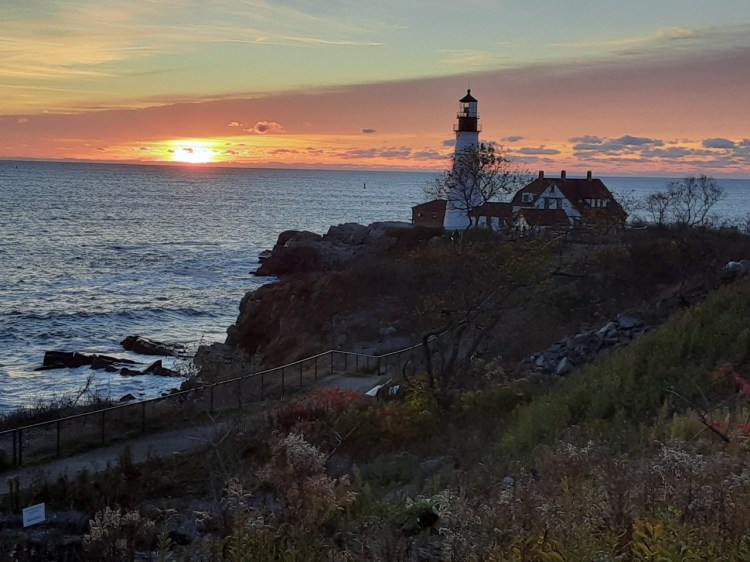In a true community undertaking, the Friends of Fort Williams Park are beginning a project that will turn an area overlooking Portland Head Light and Casco Bay from an invasive plant jungle into a showplace of native plants.
The $16,000 effort is financed by an $8,000 Project Canopy grant, with money from the U.S. Department of Agriculture through the Maine Forest Service, that was matched by $5,000 from an anonymous donor and $3,000 from the town of Cape Elizabeth.
The work will be done in a section of the park that I discussed in a column in 2017, after Kelly Corbin of the Wild Seed Project conducted an instructional walk there on how to combat invasive plants. At that time, the Cliff Walk area, which is north of the lighthouse, was a tangle of Asiatic honeysuckle, bittersweet, multiflora rose, black swallowwort and other invasive non-native plants.
Andrea Southworth, Ecology Project director of the Friends, handled the grant application and is overseeing the installation of the new plants.
So far, the most visible signs of the work are an array of fluorescent flags about three inches off the ground showing where native plants – everything from sweetfern (Comptonia peregrina) to red oaks (Quercus rubra) – have been planted. Native plants have co-evolved over millennia to feed and provide habitat for native birds, insects and other animals. The seedlings planted so far are somewhere between small and tiny, even though Project Canopy usually supports projects with larger trees and a more immediate visible impact.
“We really had to search for small pockets of soil among the rocks,” Southworth said as we walked through the area. “We couldn’t find many places that would take balled-and-burlaped trees.” (When larger trees are dug up from fields, the roots are wrapped in burlap before they are sent to nurseries to be sold, hence the term.)

The same view in the daytime. Note the new plantings next to the boulders. Photo by Stephanie Taylor
That’s not a problem in the long term, though, as studies have shown that newly planted small trees have a better survival rate than newly planted large trees. Plus, after about 10 years, the small trees catch up in size. Just one spot, an area back from the Cliff Walk trail with great views of the lighthouse, will get some larger trees in the spring. The goal is to provide a spot where visitors can take in the gorgeous views, perhaps while eating a lobster roll from a park vendor, yet be a little separate from the park’s throngs.
Much of the physical work has been done by Southworth; Alex Donka, the Friends’ head gardener; and Stephanie Taylor, a Southern Maine Community College student who started out as volunteer, moved on to intern and is now a Friends’ employee. Southworth singled out Mike Moran of Cape Elizabeth, another SMCC student, as the most frequent volunteer.
When she was writing the grant application, Southworth contacted Cheryl Rich, head of the Horticulture department at SMCC, and got a commitment that the horticulture students would provide some help, and they have. Southworth has contacts at SMCC because she teaches a botany class there. Volunteer groups have also helped in the effort to rehabilitate the Cliff Walk trail.
Almost all the work of removing invasive plants that I wrote about in 2017 was done mechanically, and without chemicals. The Portland and South Portland/Cape Elizabeth Rotary clubs cleared many of the invasive plants from a hillside. The refuse was then run through a mechanical chipper, with the chips left onsite to prevent erosion. A large group from Tom’s of Maine also did a day’s worth of clearing. A contractor cleared some areas with a mower.
So far, all of the new plants for this area of the park have been purchased from Maine companies and nonprofits, including Fedco, Maine Audubon and the Wild Seed project. Southworth had special praise for Pierson’s Nurseries in Dayton: “Where else could you find bur oak and scrub oak?” she asked, mentioning two native trees (Quercus macrocarpa and Quercus ilicifolia) that are not commercially popular.
The range of bur oak typically extends to just south of Maine, but that’s what makes it attractive to Southworth. With the warming climate, she thinks it is likely to survive at Fort Williams if other species are threatened.
Southworth has a vested interest, of course, but she thinks her project is ideal for Project Canopy. It is turning a swath of invasives into native plants, and doing it in an area where the millions of people who visit Portland Head Light each year will be able to see the transformation. The final touch will be figuring out what to say in the signs that will explain to the tourists – and locals – what was done and why it’s important.
A note about the Friends of Fort Williams Park, a group I belong to (I serve as recording secretary). The nonprofit group created and maintains four landscapes at the park, including the Children’s Garden. It is separate from, but works with, the town of Cape Elizabeth. It is funded by donations and money it raises from its annual Cape Elizabeth Garden Tour.
Tom Atwell is a freelance writer gardening in Cape Elizabeth. He can be contacted at: tomatwell@me.com.
Copy the Story LinkSend questions/comments to the editors.



Success. Please wait for the page to reload. If the page does not reload within 5 seconds, please refresh the page.
Enter your email and password to access comments.
Hi, to comment on stories you must . This profile is in addition to your subscription and website login.
Already have a commenting profile? .
Invalid username/password.
Please check your email to confirm and complete your registration.
Only subscribers are eligible to post comments. Please subscribe or login first for digital access. Here’s why.
Use the form below to reset your password. When you've submitted your account email, we will send an email with a reset code.